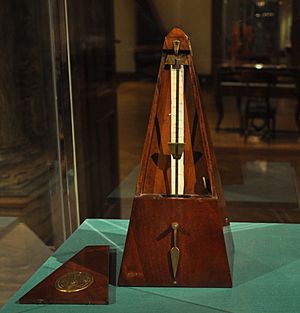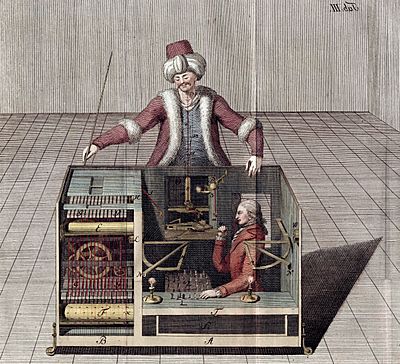Johann Nepomuk Maelzel facts for kids
Johann Nepomuk Maelzel (born August 15, 1772 – died July 21, 1838) was a clever German inventor, engineer, and showman. He is most famous for making the metronome, a device that helps musicians keep time. He also built several amazing music-playing machines called automatons. Maelzel was also known for showing off a fake chess machine called The Turk. He even worked with the famous composer Ludwig van Beethoven on a piece of music for one of his inventions.
Contents
Life and Amazing Inventions
Johann Maelzel was born in a city called Regensburg in Germany. His father built organs, so Maelzel grew up around music and machines. He learned a lot about music. In 1792, he moved to Vienna, a big city in Austria.
Early Musical Machines
After many years of learning and trying new things, Maelzel created a large musical instrument called an orchestrion. People could see it in public, and it was later sold. In 1804, he invented the panharmonicon. This was a special machine that could play the sounds of a whole military band. It worked using air from bellows and had spinning cylinders that held the musical notes.
The panharmonicon became very famous. Maelzel became well-known across Europe. He was even given a special job as the imperial court-mechanician in Vienna. Famous composers like Ludwig van Beethoven admired his work. The panharmonicon was later sold for a lot of money to someone in Paris.
The Chess Turk and Other Devices
In 1805, Maelzel bought an old chess-playing machine called The Turk. This machine was invented by Wolfgang von Kempelen. Maelzel took The Turk to Paris and sold it for a big profit. The Turk was actually a trick, with a person hidden inside making the moves.
When he returned to Vienna, Maelzel built an automaton trumpeter. This machine looked like a real person and could play French and Austrian military songs. It even changed its clothes! In 1808, he also invented a better ear trumpet to help people hear. He also made a musical chronometer, which was another device for keeping time in music.
Working with Beethoven
In 1813, Maelzel and Beethoven became good friends. Maelzel came up with the idea for a piece of music called Wellington's Victory. Beethoven then composed the music for it. This music was meant to be played on Maelzel's panharmonicon. They even held concerts together. At these concerts, Beethoven's symphonies were played along with Maelzel's amazing automatons.
Later, in 1814, Maelzel and Beethoven had a disagreement. Beethoven felt that Maelzel was trying to claim ownership of his music. He also thought Maelzel was performing the music without permission. Despite this, they seemed to make up later.
The Metronome
In 1816, Maelzel became well-known in Paris for making the metronome. This device helps musicians play at a steady speed. Maelzel's metronome was actually based on an earlier invention by Dietrich Nikolaus Winkel. By 1817, Beethoven and Maelzel were friends again. Beethoven even praised Maelzel's metronome. He said he would start using it instead of older ways to show music speed, like allegro.
After Paris, Maelzel moved to Munich and then back to Vienna. He managed to buy back von Kempelen's chess player. After spending several years building and improving more inventions, he decided to travel. He took his collection of mechanical wonders to the New World (America) to show them off.
See also
 In Spanish: Johann Mäzel para niños
In Spanish: Johann Mäzel para niños



